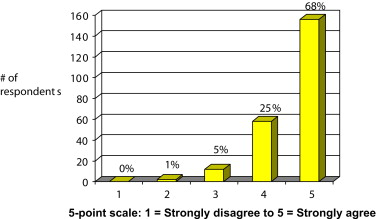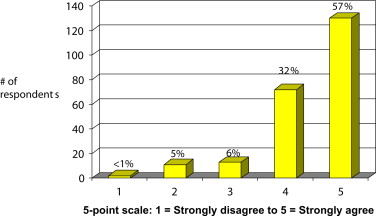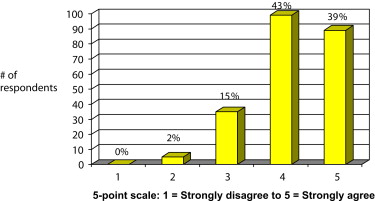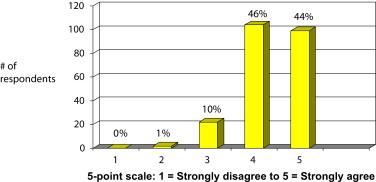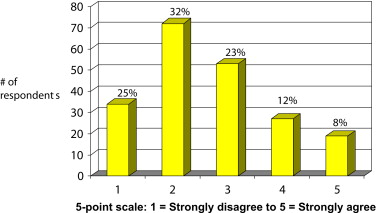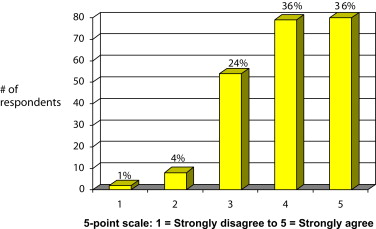Rationale and Objectives
Given escalating health care costs and limited resources, the effective utilization of imaging is essential to permit optimal patient care. Because only 21.4% of medical schools require radiology clerkships, most students do not understand the indications for and clinical effectiveness of most imaging tests. Therefore, the authors introduced two focused sessions on evidence-based imaging during the required radiology core clerkship at their institution.
Methods
From June 2008 to September 2009, 259 students in the radiology core clerkship participated in a didactic session on principles of evidence-based imaging and/or a small-group session and self-directed learning exercise using the American College of Radiology (ACR) Appropriateness Criteria. Students evaluated the exercise on a five-point scale for its effectiveness in teaching imaging strategies and its impact on their future careers.
Results
Two hundred twenty-eight of 259 students (88%; 93 third year, 135 fourth year) participated in the two sessions. Two hundred thirteen of 223 (96%) were not aware of the ACR’s Web site as a resource prior to this exercise. Two hundred fourteen of 228 (94%) found the ACR Appropriateness Criteria a useful resource. Two hundred two of 228 (89%) stated that they would likely use this resource in other clinical rotations and future practice. Two hundred three of 228 (89%) reported having a solid understanding of the indications for imaging tests following the sessions. Students praised the ACR’s Web site for its comprehensive coverage of different modalities and their relative radiation risks. They valued working collaboratively on common clinical scenarios.
Conclusion
The ACR Appropriateness Criteria are a valuable resource for teaching evidence-based imaging to medical students. A majority of students indicated that they plan to use this resource in the future.
The increased utilization of imaging due to the introduction of new technology over the past few decades has been linked to escalating health care costs . Often, new imaging techniques are widely adopted prior to establishing their cost-effectiveness. This widespread incorporation of technology into patient care is multifactorial and includes rising patient expectations for earlier diagnosis, improved access to imaging, added diagnostic certainty for providers, increased reliance on technology for answers, and concern over potential liability . Given limited resources, there is a growing need to educate physicians about the strengths and limitations of different imaging modalities for specific clinical presentations. Although imaging tests can provide useful information that may directly affect patient care, physicians must use clinical histories and findings on physical examinations to guide them to the appropriate differential diagnosis and subsequent selection of laboratory and imaging tests. Without the benefit of an adequate history and physical examination, providers are apt to rely on a battery of tests, leading to untoward risk to patients and unnecessary costs to the health care system. Knowledge regarding the cost-effectiveness of different imaging modalities is essential to optimize patient care.
Over the past decade, there has been increasing interest in evidence-based medicine and, more recently, evidence-based imaging. Defined as combining the best scientific evidence with physician expertise and patient expectations , evidence-based imaging can be expected to play a pivotal role to help physicians choose the “best” or most cost effective imaging tests for their patients. This approach will likely translate into stabilization of health care costs related to imaging and more appropriate patient care, as no imaging test is without risk.
Get Radiology Tree app to read full this article<
Get Radiology Tree app to read full this article<
Get Radiology Tree app to read full this article<
Methods
Get Radiology Tree app to read full this article<
Table 1
Selected Topics for Evidence-based Imaging Session
Pneumonia Aortic dissection Acute appendicitis Pulmonary embolism Colorectal cancer screening Small-bowel obstruction Solitary pulmonary nodule on preoperative chest film Suspected MI/acute chest pain Abnormal screening mammographic results Blunt chest trauma New-onset seizures Jaundice with RUQ pain Back pain Acute stroke Acute GI bleeding Shoulder dislocation Headache in HIV-positive adult Vaginal spotting in postmenopausal woman Hematuria Acute head trauma in child Blunt abdominal trauma Renal colic UTI in a child Acute pancreatitis Acute scrotal pain
GI, gastrointestinal; HIV, human immunodeficiency virus; MI, myocardial infarction; RUQ, right upper quadrant; UTI, urinary tract infection.
Get Radiology Tree app to read full this article<
Get Radiology Tree app to read full this article<
Results
Get Radiology Tree app to read full this article<
Get Radiology Tree app to read full this article<
Get Radiology Tree app to read full this article<
Get Radiology Tree app to read full this article<
Discussion
Get Radiology Tree app to read full this article<
Get Radiology Tree app to read full this article<
Get Radiology Tree app to read full this article<
Get Radiology Tree app to read full this article<
Get Radiology Tree app to read full this article<
Get Radiology Tree app to read full this article<
Appendix
Evidence-based Imaging Session Questionnaire
Get Radiology Tree app to read full this article<
Get Radiology Tree app to read full this article<
Get Radiology Tree app to read full this article<
Get Radiology Tree app to read full this article<
Get Radiology Tree app to read full this article<
Get Radiology Tree app to read full this article<
Get Radiology Tree app to read full this article<
Get Radiology Tree app to read full this article<
Get Radiology Tree app to read full this article<
Get Radiology Tree app to read full this article<
Get Radiology Tree app to read full this article<
Get Radiology Tree app to read full this article<
Get Radiology Tree app to read full this article<
Get Radiology Tree app to read full this article<
Get Radiology Tree app to read full this article<
Get Radiology Tree app to read full this article<
Get Radiology Tree app to read full this article<
Get Radiology Tree app to read full this article<
Get Radiology Tree app to read full this article<
Get Radiology Tree app to read full this article<
Get Radiology Tree app to read full this article<
Get Radiology Tree app to read full this article<
Get Radiology Tree app to read full this article<
Get Radiology Tree app to read full this article<
Get Radiology Tree app to read full this article<
Get Radiology Tree app to read full this article<
References
1. Smith-Bindman R., Miglioretti D.L., Larson E.B.: Rising use of diagnostic medical imaging in a large integrated health system. Health Aff (Millwood) 2008; 27: pp. 1491-1502.
2. Rowan K.: Rising costs of medical imaging spur debate. J Natl Cancer Inst 2008; 100: pp. 1665-1667.
3. Studdert D.M., Mello M.M., Sage W.M., et. al.: Defensive medicine among high-risk specialist physicians in a volatile malpractice environment. JAMA 2005; 293: pp. 2609-2617.
4. Ertuk S.M., Ondategui-Parra S., Otero H., et. al.: Evidence-based radiology. J Am Coll Radiol 2006; 3: pp. 513-519.
5. American College of Radiology. ACR Appropriateness Criteria. Available at: http://www.acr.org/secondarymainmenucategories/quality_safety/app_criteria.aspx . Accessed March 17, 2010.
6. Association of American Medical Colleges. Curriculum directory. Available at: http://services.aamc.org/currdir/index.cfm . Accessed November 18, 2009.
7. Scheiner J.D., Novelline R.A.: Radiology clerkships are necessary for teaching medical students appropriate imaging work-ups. Acad Radiol 2000; 7: pp. 40-45.
8. Mettler F.A., Bhargavan M., Faulkner K., et. al.: Radiologic and nuclear medicine studies in the United States and worldwide: frequency, radiation dose, and comparison with other radiation sources—1950-2007. Radiology 2009; 253: pp. 520-531.
9. Abella HA. Senate bill ties physicians’ pay to appropriateness criteria. Available at: http://www.diagnosticimaging.com/news/display/article/113619/1470726?verify=0 . Accessed March 17, 2010.
